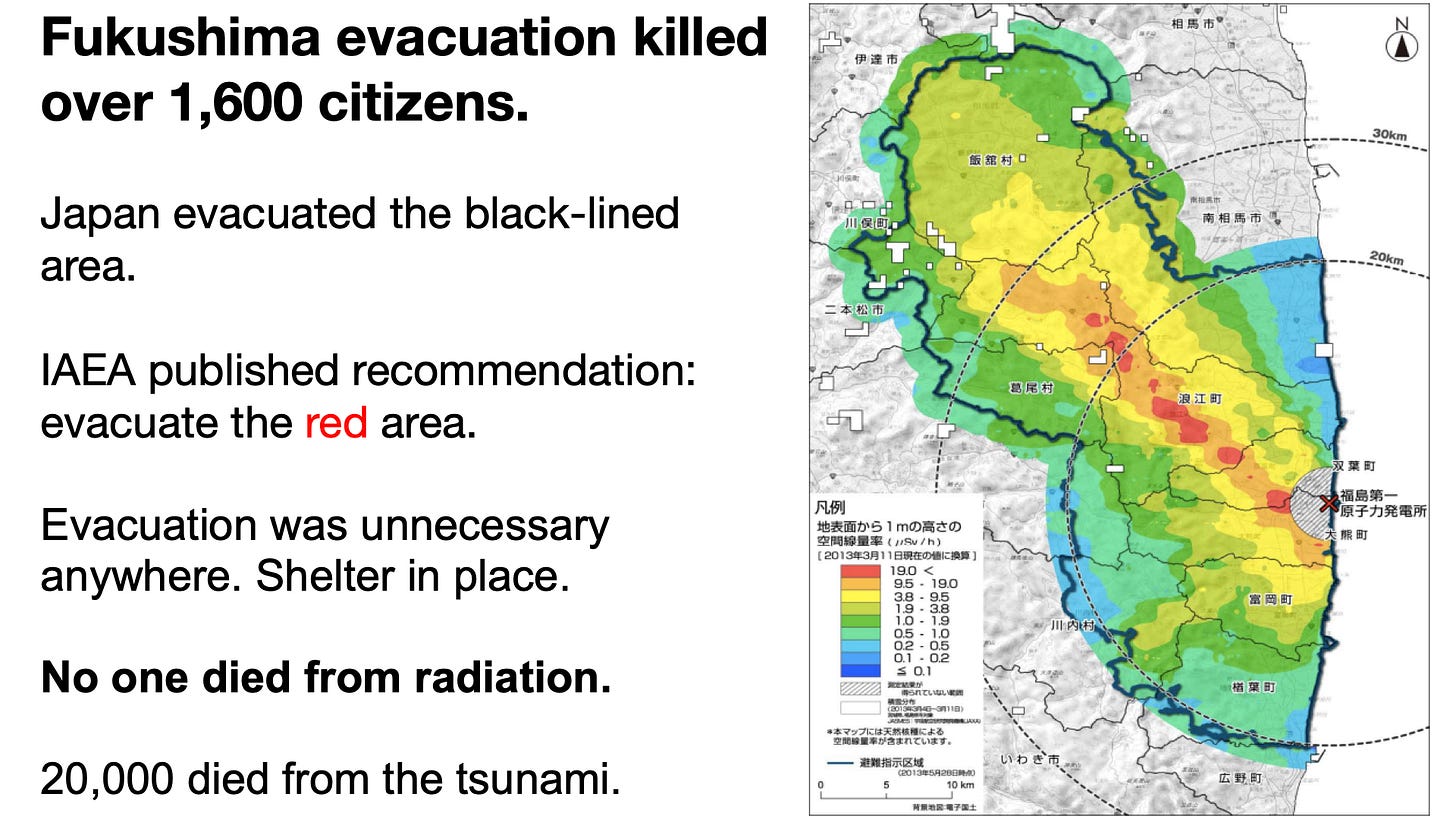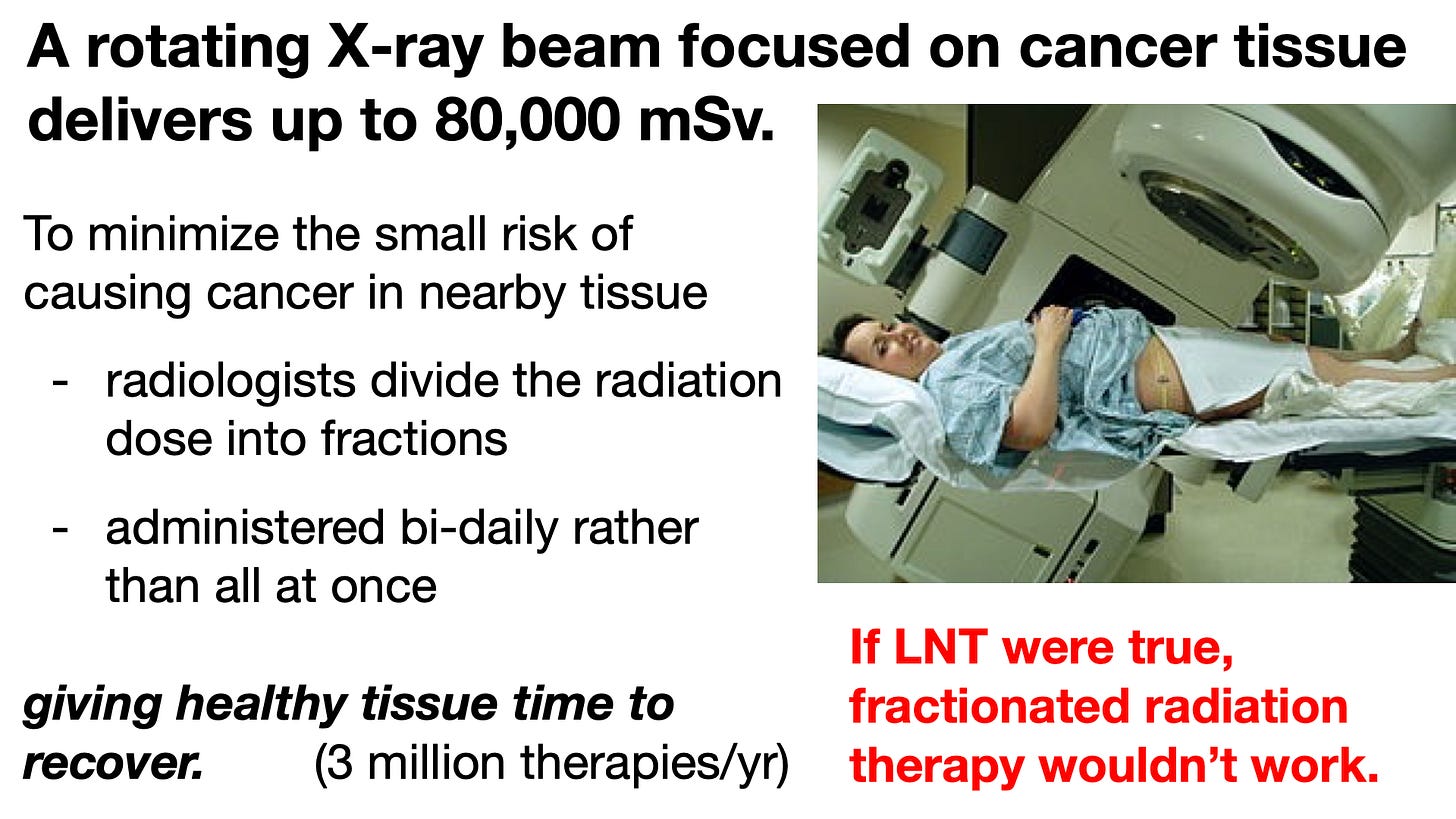Nuclear power radiation is generally benign.
Regulators have little understanding of the biology, and they ignore the observations.
This post continues on from
Renewable energy gives way to natural gas.
But US regulators want perfectly safe nuclear power.
Nuclear radiation is generally benign, even in most power plant accident conditions. Medical radiation, too, is generally benign.
Fear sells! Media can not resist the temptation to prey on public fears to publish such click bait. CT scans use multiple X-rays to create a 3D image of the body, exposing people to 10 to 20 mSv of radiation. There is no observed evidence of cancer caused by such low doses.
Regulators and radiation protection industry NGOs deny that the standard dose-response S-curve explains radiation effects. They thoughtlessly extrapolate high dose effects down to low dose effects, then multiply by number of exposed people to concoct a high dose effect.
Here’s another example.
The first atomic bomb was made from U-235 (1% of natural uranium). Near the end of World War II the US built special purpose nuclear reactors to convert plentiful U-238 (99% of natural uranium) to plutonium to become the explosive core of an atomic bomb, such as used at Nagasaki.
Radioactive waste from the effort contaminates the Hanford, WA, reservation, so the decision was made to clean it up, even though the environmental impact statement reported the do-nothing option was equally safe. The last sentence above comes from Maddie Hilly’s article, my emphasis added.
I don’t mean to pick exclusively on the New York Times, but to point out that even reputable media fail to follow up and seek out the fundamental truths about radiation. It’s generally benign. We’re wasting half a trillion dollars for no benefit.
A study of 86,611 atomic bomb survivors’ health effects associated with radiation exposures began 5 years after the atomic bombs exploded. A numerical model of the blast estimated radiation absorbed by each survivor based on their recalled location.
The leftmost, blue bar represents cancer rate of 21% for those residents who happened not to be in the cities when the two atomic bombs exploded. They are the control group. The green bar is for people exposed to 0 to 5 mSv, and the orange bar for exposures from 5 to 100 mSv. The cancer rate is still 21%, unchanged.
Above that the data suggested that lifetime cancer incidence increased proportional to their instantly absorbed radiation energy, at 1% per 100 mSv. People typically receive 6 mSv annually, half from natural radiation, half from medical radiation.
There were no cancers associated with radiation less than 100 mSv. The idea of a cancer threshold at 100 mSv created controversy. The International Council on Radiation Protection (ICRP) and national regulators ignored the observational science and instead adopted the precautionary principle to claim there is no safe radiation at all. Regulators then mistakenly set annual, cumulative limits to 1 mSv, 1/100th of the posited cancer threshold for an instant exposure. They err by a factor of 365x100.
The US NAS published graphic did not show an increase in cancer below 100 mSv.
The US NCRP graph on the right similarly squeezes the vast majority of all observational data into invisibility. On the left the UN Scientific Commission on Effects of Atomic Radiation displays the same data in detail, illustrating no observed increase in cancer below 100 mSv.
Because politicians and regulators were ignorant about generally benign radiation, citizens were quickly evacuated from areas where radiation exceeded roughly 20 mSv/year (~2 µSv/hour). No one died from radiation at Fukushima, nor at the prior Three Mile Island accident.
At Chernobyl over 100 of first responders trying to control the radioactive materials were sickened with acute radiation syndrome, and about 28 died from it. Hundreds of children may have contracted thyroid cancer from milk from cows grazing on radioactive iodine contaminated grass, and over 1000 children had thyroid glands removed, because common, tactable, benign nodules were thought to be cancer without further diagnosis. Over a dozen children died. All would have lived had the population been warned not to drink the milk for 90 days. The half-life of radioactive iodine-131 is only 8 days.
No increase in cancer incidence in the fallout regions was observed, though the New York Academy of Sciences publication reported nearly a million cancers would result.
Atoic bomb testing once exposed US citizens to even more radiation than did Fukushima.
High radiation doses are deadly to cancer cells, and potentially to healthy tissue. Radiation oncologists rotate the beams of X-rays to reduce exposure to health tissues near the cancer site. They also divide the dose into every-other-day fractions, creating time for healthy tissue to recover.
Normal metabolism taking place within human cells creates hydrogen peroxide (H2O2) and other oxygen species that disrupt chemical bonds in DNA strands, at about 1 break per second per cell. Such strands are repaired quickly since the opposite stand is a mirror image. Double strand breaks (DSBs) are also repairable. Multiple, close-together DSBs create a risk of misrepair. Such cells normally die or become senescent (not reproductive) but rarely may procreate as a cancer.
Regulators and radiation NGOs ignore the new scientific information published a decade ago.
Scientists at the University of California have produced time lapse photography of the progression of DNA repairs within assemblages of proteins that repair DSBs. These processes start within seconds of damage from metabolism or radiation damage.
My retired University of Oxford friend, Wade Allison, has written books about benign radiation. This graphic communicates the range of radiation effects. The tiny black dot in the green circle represents the 1 mSv per year radiation dose limit typically enforced by regulators.
Health harm is not observed for radiation dose rates under 20 mSv/day. A regulatory limit of 2 mSv per day, as established in the 1930s, would provide the public with a safety factor of 10:1.
Nuclear power plants should cost under $2/watt.
There is no good reason for nuclear power plants to cost more. Historically they did cost $2/watt in current dollars. The iron grip of regulators has ratcheted costs up. We see China building Westinghouse-designed AP1000 plants for $2.4/watt, not $13/watt.
First, we need to show and teach people that radiation from nuclear power operations is benign, even in most accident conditions.
Second, we need to discredit the regulators and radiation protection industry that continues to benefit from unsubstantiated harm theories, then end the permission-based, obstructing regulatory regime.
Third, we can allow experience and competition among suppliers to bring down nuclear power costs. These companies can provide safety the same way as other energy suppliers do. Their coal plants, natural gas plants, and hydro dams are relatively safe, backstopped with insurance policies for compensation in the event of measurable harm.
To be continued.
















This is the best yet I have read on Fear of Radiation. Well sourced and very clear, even for non technical readers. I need to update Citizendium's article. Suggestions are welcome, especially for our Debate Guide page, where we still have some unanswered arguments from the pro-LNT side.
https://citizendium.org/wiki/Fear_of_radiation
Question: If normal metabolism disrupts chemical bonds in DNA strands, at about 1 break per second per cell, and DNA repair times are about one hour, how can repairs keep up with the damage?